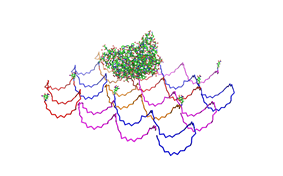Team:Freiburg
From 2008.igem.org
m |
|||
| (85 intermediate revisions not shown) | |||
| Line 2: | Line 2: | ||
Content= | Content= | ||
<div style="font-size:18pt;"> | <div style="font-size:18pt;"> | ||
| - | <font face="Arial Rounded MT Bold" style="color:#010369">_welcome!</font></div> | + | <font face="Arial Rounded MT Bold" style="color:#010369">_welcome!</font></div><br><br> |
| + | [[image:Freiburg2008_extracts.png|800px]]<br> | ||
<br> | <br> | ||
| - | [[Image: | + | [[Image:Freiburg2008_Fab_on_Origami_animated.gif|right|300 px]] |
| - | + | The first German team ever to participate in iGEM is back again, providing you with an excellent set of [[Team:Freiburg/Parts|fusion proteins]] for modular use as [http://partsregistry.org/cgi/partsdb/pgroup.cgi?pgroup=iGEM2008&group=Freiburg BioBricks]. This year we are crafting a [[Team:Freiburg/Project|synthetic receptor kit]] "made in Black Forest", using [[DNA-Origami]] as programmable input device and the complementation of split-fluorophores and -enzymes as readable output.<br> | |
| - | The first German team to participate in iGEM | + | An [https://2007.igem.org/Freiburg07/report_fusion_parts extension of the standard] BioBrick Pre- and Suffix, developed by iGEM-Team Freiburg 2007, allows in-frame-cloning of proteins without generation of a stop-codon at the "scar", so that we can fuse practically any number of proteins and/or peptides - as you can see in our [[Team:Freiburg Cloning Strategy|cloning strategy]] page. Of course, we want to share this possibility with future iGEM-Teams and have added a new, fully compatible [http://partsregistry.org/Part:BBa_K157000 plasmid] to the registry. |
| - | < | + | <br><br> |
| - | == == | + | [[Image:Freiburg2008_Bilderleiste.jpg|800px]] |
| + | == Project Abstract == | ||
| + | |||
| + | <br> | ||
| + | <table> | ||
| + | <tr> | ||
| + | <td> | ||
| + | [[Image:Freiburg08_MSRS_Schema.png|thumb|270px|left|Schematical overview of the system]] | ||
| + | <br><br><br><br><br><br><br><br><br><br><br><br><br><br><br><br><br><br><br><br><br><br><br> | ||
| + | </td> | ||
| + | <td> | ||
| + | '''Modular Synthetic Receptor System:'''<br> | ||
| + | |||
| + | Signaling through membranes is a characteristic of life. Transmembrane proteins control proliferation, differentiation, and cellular response and are key for the formation of multicellular organisms. Controlling such proteins enables modifying cellular behavior and ultimately programming cells at will. The complex rules for transmembrane signaling often require engagement of several proteins in a fine-tuned spatial and temporal manner. | ||
| + | |||
| + | To tap possibilities of transmembrane programming, the Freiburg 2008 iGEM team provides an extensible system comprising an external framework with spatial resolution, a concept for modifying natural receptors, and a modular set of fusion-Biobricks for the construction of synthetic receptors. Spatial resolution in the nanometer scale is provided by DNA-Origami modified with distinct patterns and combinations of ligands. Receptors are decoupled from their natural ligands by fusion with artificial binding domains. The Biobrick collection contains signal sequences, binding domains, transmembrane domains, and effector domains featuring split enzymes and split fluorescent proteins for immediate readout.<br> | ||
| + | For details see the [[Team:Freiburg/Project|Project Report :]]<br> | ||
| + | <ul> | ||
| + | *[[Team:Freiburg/Modeling|Modeling]]<br> | ||
| + | *[[Team:Freiburg/3D-Modeling|3D-Modeling]]<br> | ||
| + | *[[DNA-Origami|DNA-Origami]]<br> | ||
| + | *[[Team:Freiburg_Cloning Strategy|Cloning Strategy]]<br> | ||
| + | *[[Team:Freiburg_Transfection and Synthetic Receptor|Transfection and Synthetic Receptor Activation]]<br> | ||
| + | *[[Team:Freiburg_Calcium Imaging|Cell Stability, Ca<sup>2+</sup> Signaling and DNA-Origami-Binding]] | ||
| + | </ul> | ||
| + | </td> | ||
| + | </tr> | ||
| + | </table> | ||
| + | <br> | ||
| + | == == | ||
[[Team:Freiburg_Sponsoring|Supporters:]]<br><br> | [[Team:Freiburg_Sponsoring|Supporters:]]<br><br> | ||
[[Image:Freiburg2008_Sponsorenleiste2.png|830px]] | [[Image:Freiburg2008_Sponsorenleiste2.png|830px]] | ||
Latest revision as of 15:47, 15 November 2008
|
Home |
_welcome! The first German team ever to participate in iGEM is back again, providing you with an excellent set of fusion proteins for modular use as [http://partsregistry.org/cgi/partsdb/pgroup.cgi?pgroup=iGEM2008&group=Freiburg BioBricks]. This year we are crafting a synthetic receptor kit "made in Black Forest", using DNA-Origami as programmable input device and the complementation of split-fluorophores and -enzymes as readable output. Project Abstract
|
 "
"





